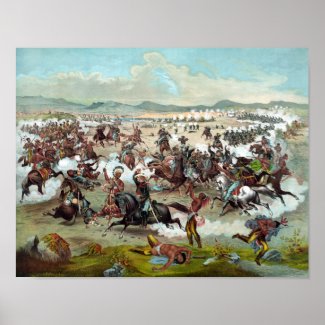 Custer’s Last Stand Poster |
Representatives from many Native nations of the Plains will come together today for the 138th anniversary of the Battle of Little Big Horn, where a re-dedication ceremony of the newly completed Indian Memorial will take place.
Doug Bissonette, the Pine Ridge spokesman for the family of Crazy Horse, said the Big Horn Riders will arrive from Pine Ridge in two groups of 20, “as they do each year in memory of the battle.” Northern Cheyenne youth, whose ancestors fought at Little Big Horn, will also participate with a run to honor them.
Lakota historian and author Donovin Sprague said, “The purpose of the Indian Memorial is to honor American Indian people whose names were often not included.” Sprague is a descendant of Crazy Horse, High Backbone (Hump), and other battle participants.
The Indian Memorial represents warrior-descendants of the battle from 17 tribes throughout the Northern Plains and Oklahoma. Engravings, artwork and imagery honor Native participants who fought and died in the Battle of the Little Bighorn. The theme is “Peace Through Unity.”
Peace through unity was echoed by Traditional Chief Phillip Whiteman, Northern Cheyenne, who said, “My great-grandparents were chiefs and warriors at Little Big Horn and we carry this message to the future generations. Days before the battle, my ancestors were summoned to Medicine Deer Rock, which is a portal to a higher dimension. Sitting Bull had a vision there of soldiers falling into the camp like locusts. That vision, that dream, has propelled us forward to where we are today. Medicine Deer Rock reminds us that the old formula of resistance, of being against something, is over now. That whole thought process is over. We have to stand up for what we are for, not against,” Whiteman said.
“Our ancestors were given a clear message. In order for our two-legged to exist together collectively, we have to walk in peace, balance and harmony for all living things. Air, land, water, language, and culture are all one and the same. Today we have the opportunity to return to that oneness. The Battle of Little Big Horn is part of the paradigm shift—it is part of the bigger vision of what our ancestors came together for at Rosebud Creek, near the Medicine Deer Rock: of learning to fight not to fight.”
On June 6, 1876, a Sun Dance was held at Rosebud Creek near Medicine Deer Rock. Somewhere between 6,000 and 10,000 people had come together from different tribes. Chief John Grass, Hunkpapa Lakota, reported that Crazy Horse was there, and Sitting Bull was singing and “making himself holy.” They knew from the vision that Custer was coming, and they were prepared. “We had scouts for many days watching Custer and Crook,” Grass said in a testimony he gave Colonel Welch in 1915.
Grass said that close to 600 men left a trail for Custer to find. “Custer never knew about this part of our march, but he should have known,” Grass said.

